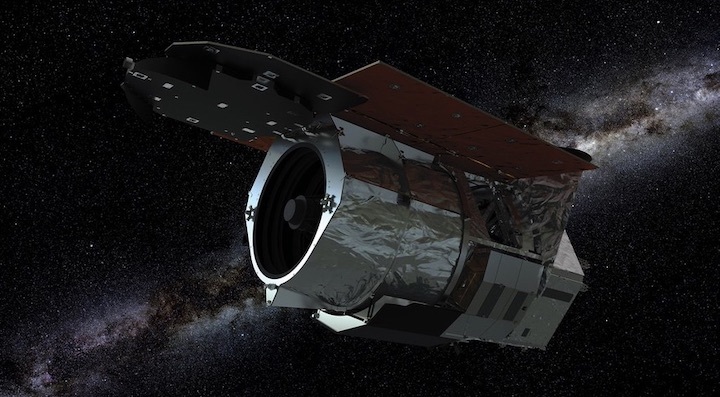16.07.2020

WASHINGTON — An appropriations bill to be considered by the full House Appropriations Committee July 14 would restore funding to five NASA science missions and projects that the administration’s budget proposal sought to cancel for fiscal year 2021.
The committee released July 13 the report accompanying its Commerce, Justice and Science (CJS) spending bill, which provides additional details about funding levels and directions to NASA and other agencies included in the bill. The CJS subcommittee favorably reported the bill July 8 to the full committee, which will consider it July 14 along with two other spending bills.
The report sharply criticized what is called an “ominous shift” away from Earth science and educational programs in favor of exploration programs it argued were being expedited solely for political purposes.
“These programs are being rushed to meet a politically motivated timeline to again place humans on the Moon’s lunar surface in a little over four years,” the report states. “In order to fund this massive expansion, the Administration chose to either reduce or eliminate many critical legacy programs, including Earth science programs that help monitor the environment, measure global climate change, and track rising sea levels.”
The bill released last week increased overall science and education funding by more than $900 million compared to the administration’s fiscal year 2021 request in February. The text of the bill provided few details about specific projects beyond restoring the agency’s education, or STEM Engagement, programs that had once again been targeted for termination by the administration’s proposal.
The report, though, confirmed that the bill restores funding for the Plankton, Aerosol, Cloud, ocean Ecosystem (PACE) and Climate Absolute Radiance and Refractivity Observatory (CLARREO) Pathfinder missions in NASA’s Earth science program, which had been targeted for termination in the fiscal year 2021 budget request, as they had the previous three years.
It also restores funding for the Roman Space Telescope (formerly WFIRST) in NASA’s astrophysics program, along with the Stratospheric Observatory for Infrared Astronomy (SOFIA), an airborne observatory NASA proposed shutting down in the fiscal year 2021 request. In planetary science, it provides $11 million for continued operations of the Mars Odyssey spacecraft, a Mars orbiter mission launched in 2001 that the agency had proposed shutting down in the budget request.
NASA’s Europa Clipper mission, the only science mission mentioned specifically in the bill last week, would receive $403.5 million in the House, the amount sought by the agency. The bill, for the first time, opened the door to launching the mission on a vehicle other than the Space Launch System, which past bills had mandated.
“The Committee believes that the Clipper mission should use a vehicle to support a launch to reduce overall mission costs and complexity and expedite science results in concert with the decadal survey,” the report states. NASA has argued that it could save hundreds of millions of dollars using a commercially procured vehicle, although it would involve a longer flight time than the SLS.
The bill provides no funding for a follow-on lander mission to Europa despite direction in the bill to launch such a mission by 2027, a date the science community widely believes is premature. The report, though, asks NASA to include “adequate funding” for the lander mission in its 2022 budget request for continued research and development work on the concept.
Despite its criticism of NASA’s accelerated Artemis program, the bill says little about the Human Landing System program, for which the bill provides $628.2 million, versus a request of more than $3.3 billion. “Funding is provided for the lunar lander office to lead the support of NASA’s lunar lander development oversight,” the report states, offering no other direction about the program.
The report also reveals a cut in another NASA priority, commercial low Earth orbit (LEO) development. NASA sought $150 million for that effort, which includes supporting work on commercial space station modules and free-flying facilities as well as stimulating commercial demand. The bill, though, offers only $15 million for that program, the same in 2020. It also directs NASA to study “the costs, benefits, and challenges of repurposing launch vehicle upper stages as free-flying platforms for habitation or industrial modules.”
By contrast, the SLS program received more than $340 million above the request, including direction to continue development of the Exploration Upper Stage for the rocket’s Block 1B version. The report directs NASA to seek an independent reviewer “with aerospace production management experience” to look for cost savings in future production of the rocket. It also instructs NASA “to study the procedures required to designate an integrator for private sector customers who wish to acquire an SLS vehicle.” There is little evidence of any private sector interest in the SLS.
The space technology section of the report reiterated the House’s support for the Restore-L (now OSAM-1) satellite servicing mission and nuclear thermal propulsion, which were both mentioned in the bill. It also increases funding for NASA’s Flight Opportunities program for suborbital research by $10 million from the request, to $30 million. The report, though, suggests expanding the program to orbital missions, stating that a goal of the effort is to “allow for more frequent access to relevant launch environments, including low-Earth orbit.”
Quelle: SN
